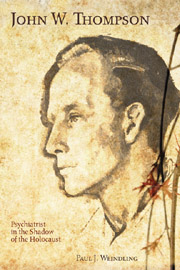Book contents
- Frontmatter
- Contents
- List of Illustrations
- Acknowledgments
- List of Abbreviations
- Part One Into the Dark
- 1 “Ecce Homo”
- 2 Mexican Childhood
- 3 Palo Alto Schooling, Stanford Student
- 4 Transatlantic Physiologist
- 5 Edinburgh Physician
- 6 Excitable Harvard
- 7 High Altitude and Rapid Descent
- 8 Auden, Anxiety, and the German Mind
- Part Two Redemption
- Part Three Aftermath
- Appendix John Thompson's Writings
- Notes
- Sources
- Index
7 - High Altitude and Rapid Descent
from Part One - Into the Dark
Published online by Cambridge University Press: 12 September 2012
- Frontmatter
- Contents
- List of Illustrations
- Acknowledgments
- List of Abbreviations
- Part One Into the Dark
- 1 “Ecce Homo”
- 2 Mexican Childhood
- 3 Palo Alto Schooling, Stanford Student
- 4 Transatlantic Physiologist
- 5 Edinburgh Physician
- 6 Excitable Harvard
- 7 High Altitude and Rapid Descent
- 8 Auden, Anxiety, and the German Mind
- Part Two Redemption
- Part Three Aftermath
- Appendix John Thompson's Writings
- Notes
- Sources
- Index
Summary
Scientific Mobilization
“He can read frightened hands,” announced Time magazine in 1939. The scientific miracle worker and dashingly photogenic “Young Physiologist” John West Thompson went to Kansas City to convince the Association of Military and Flight Surgeons that he could measure fear reactions of pilots. He named his new machine a “Haematometharmozograph,” literally a blood hemoglobin graph. The idea was that fear constricts blood vessels. He measured the constriction by the amount of light that could pass through a person's hand. The device was “a simple two hundred dollar contrivance” made from a photoelectric cell, an electric light bulb, and an oscillograph to record electrical pulses. Thompson read descriptions of fearful accidents to experimental subjects. The more frightened the subject, the more translucent the hand, thus detecting those pilots who “become unnerved when under stress.”
The Military and Flight Surgeons Conference marked Thompson's crossing over from human physiology into aviation medicine at a time of heightened anxieties about war. Thompson demonstrated how emotions resulted in bodily changes and could affect performance, reactions, and sensations. Although the apparatus delivered credible results, it was silent about the anxieties and fears of the scientist carrying out the measurements.
U.S. Army Air Corps experts visited the Harvard Fatigue Laboratory in March 1939, and Canadian physiologists visited in November. The human performance tests selected those who could withstand physically demanding tasks. Aviation medicine was taking off as war loomed.
- Type
- Chapter
- Information
- John W. ThompsonPsychiatrist in the Shadow of the Holocaust, pp. 63 - 75Publisher: Boydell & BrewerPrint publication year: 2010

